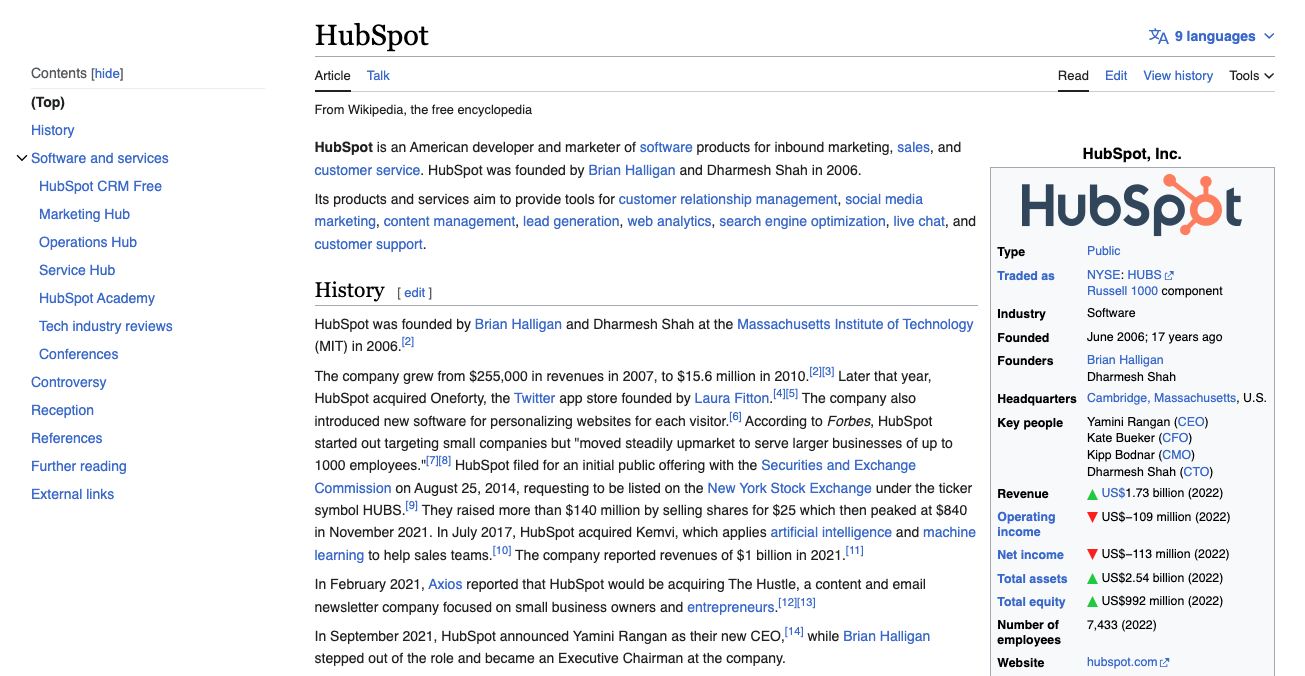Wikipedia is a vast encyclopedia that contains information on everything from animal facts to our favorite television shows.
The community of editors and writers on the internet is one of the main reasons for the wealth of knowledge that Wikipedia has. You might be wondering, , “How do I promote my brand on Wikipedia?”, or , “Can I create a Wikipedia page for my company?”.
Wikipedia is a great source for ranking high on Google’s first page. This year, we’ll explore the basics of creating a page, the top business pages and guidelines for publishing Wikipedia pages.
How Can You Create A Wikipedia Page For Your Business?
You can make a Wikipedia page with administrative rights, but you must always adhere to the guidelines of Wikipedia and be objective in your additions. Avoid any advertorial material at all cost.
The Benefits of Owning a Wikipedia page
Wikipedia is a non-biased, community-driven encyclopedia. Due to its nature, and its stated mission, biased and overly-promotional material can be removed or go against the guidelines. It’s not recommended to edit or create pages for a company you work with or own. This can be difficult to maintain unbiased listings.
1. Credibility and authenticity of a brand.
A presence on Wikipedia will enhance the credibility of your brand. Wikipedia is trusted by millions as their primary information source. A well-written page with proper citations can show potential clients, investors, and partners that your company is established and legitimate.
2. Search engine visibility and rankings are improved.
Search engine result pages (SERPs) often feature Wikipedia pages at the top. A Wikipedia page will increase the visibility of your company online, making it easy for customers to discover and find your brand. It can help improve your organic search ranking, increase traffic to the website and lead to increased conversions.
3. Access to an international audience
Wikipedia can be accessed in many languages by users from around the globe. A Wikipedia page allows you to reach an international audience that may include potential clients, partners and investors. It can expand your market reach, and create new opportunities for business in different markets.
How to create a Wikipedia page for your company
- Create a Wikipedia account.
- Promoted to auto-confirmed users.
- Create the page.
- Citations are required.
- Make sure you follow the Creative Commons Guidelines.
- Audit neutrality is maintained.
- Send the page to be reviewed.
- Regularly update your website.
Please note: This step will show you screenshots from the Wikimedia site that include trademarked logos.
The Wikimedia Foundation has granted permission to use the Wikimedia Foundation wordmarks and logos. HubSpot is not affiliated or endorsed in any way by the Wikimedia foundation.
1. Create a Wikipedia account.
Click “Create an account” at the top-right corner of Wikipedia.

Image Source
Click “Create Your Account” and enter the required information including your username and password.
2. Promoted to auto-confirmed users.
You’ll notice a pop-up box that says “Help improve Wikipedia”, with a button to edit an article.

Image Source
You’ll first need to be an automatic confirmed user.
Wikipedia has a standard set of guidelines that define an autoconfirmed account: “Although requirements vary depending on the circumstances, accounts older than four days and with at least 10 edits made (including those deleted) will be considered to have autoconfirmed.
You’ll have to be patient here. Spend the first few days after you create an account, editing pages of other users. You can edit a page by clicking “Edit a Page”. There are links to “Edit” at the top of each paragraph.
After autoconfirming, move on to the next stage.
3. Create a page.
We’re now at the hardest part – creating the page.
Go to Wikipedia and click on “Writing an Article”. You’ll notice a button in blue that says “Article Wizard: An easy way to Create Articles” as you scroll down. This button will appear (as soon as your autoconfirmation is complete):

Image Source
You’ll then be directed to the Article Wizard on Wikipedia. You have two choices: either click “Next” to create your page immediately, or edit your page first in Wikipedia’s Sandbox.
Click “Next” to proceed.

Image Source
You can add as much information or as little as you like, since your company’s Wikipedia page is likely to be blank. You’ll also want to organize the page so that it is easy to read, putting the most basic and important information first (such as what your business does).
Take a look, for example, at the structure of HubSpot’s Wikipedia page:

Image Source
On the page, you’ll find a brief overview (two sentences) of HubSpot, a table-of-contents on the left and an “information sheet” to the right. You’ll find HubSpot history below the table of content, then a description HubSpot software and services.
The information above the fold on HubSpot’s Wikipedia page is most likely to be useful to a visitor who’s never heard of HubSpot. She can quickly learn what HubSpot offers, how much money it makes, as well as what Forbes and other third-party sites have said about HubSpot.
Wikipedia should be used to spread brand awareness. While the reader can scroll down for product specific information, Wikipedia’s main purpose is to provide a platform that allows readers access more generalized brand knowledge.
Later on, we’ll examine more examples.
4. Citations are required.
Wikipedia is an encyclopedia. To prove that your topic has validity, it’s important to include references to articles from other sources.
Wikipedia cautions that you should check independent sources for the topic before you start creating your article. Journals, books, magazines, newspapers and websites that have a good reputation for fact checking are all examples. social media, press releases, or corporate/professional profiles do not qualify”:
